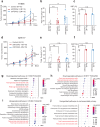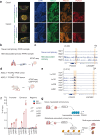FOXA2 promotes metastatic competence in small cell lung cancer
- PMID: 40419484
- PMCID: PMC12106783
- DOI: 10.1038/s41467-025-60141-5
FOXA2 promotes metastatic competence in small cell lung cancer
Abstract
Small cell lung cancer (SCLC) is known for its high metastatic potential, with most patients demonstrating clinically evident metastases in multiple organs at diagnosis. The factors contributing to this exceptional metastatic capacity have not been defined. To bridge this gap, we compare gene expression in SCLC patient samples who never experienced metastasis or relapse throughout their clinical course, versus primary SCLC patient samples from more typical patients who had metastatic disease at diagnosis. This analysis identifies FOXA2 as a transcription factor strongly associated with SCLC metastasis. Subsequent analyses in experimental models demonstrates that FOXA2 induces a fetal neuroendocrine gene expression program and promotes multi-site metastasis. Moreover, we identify ASCL1, a transcription factor known for its initiating role in SCLC tumorigenesis, as a direct binder of the FOXA2 promoter and regulator of FOXA2 expression. Taken together, these data define the ASCL1-FOXA2 axis as a critical driver of multiorgan SCLC metastasis.
© 2025. The Author(s).
Conflict of interest statement
Competing interests: A.Q.V. has received honoraria from and is currently fully employed by Astra Zeneca. J.M. holds company stock from Scholar Rock. C.M.R. has consulted regarding oncology drug development with AbbVie, Amgen, Astra Zeneca, Boehringer Ingelheim, Daiichi Sankyo, Genentech/Roche, Jazz, and Merck, and serves on the scientific advisory boards of Auron, Bridge Medicines, DISCO, Earli, and Harpoon Therapeutics. C.M.R. has received licensing fees and royalties based on DLL3 antibody-based therapeutics. The remaining authors declare no competing interests.
Figures






References
-
- Kawasaki, K., Rekhtman, N., Quintanal-Villalonga, Á. & Rudin, C. M. Neuroendocrine neoplasms of the lung and gastrointestinal system: convergent biology and a path to better therapies. Nat. Rev. Clin. Oncol.20, 16–32 (2023). - PubMed
MeSH terms
Substances
Grants and funding
- U24-CA213274/U.S. Department of Health & Human Services | NIH | National Cancer Institute (NCI)
- R35 CA252978/CA/NCI NIH HHS/United States
- R35-CA252978/U.S. Department of Health & Human Services | NIH | National Cancer Institute (NCI)
- R35-CA263816/U.S. Department of Health & Human Services | NIH | National Cancer Institute (NCI)
- U24 CA213274/CA/NCI NIH HHS/United States
LinkOut - more resources
Full Text Sources
Medical
Miscellaneous

